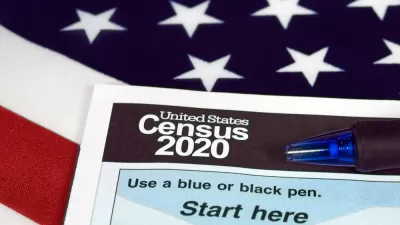An article for Planning magazine readies the planning profession for the largest peacetime activity of the federal government. All indications are that the 2020 Census will include unprecedented changes.

"That's right. It's almost census time, an American tradition since 1790," writes Christopher Williamson.
Williamson's post is a call to action for planners to understand the significance of the Census for their work, as well as possibly to participate in the Census process once it's running in full force in 2020.
First Williamson, notes the many changes that are still under consideration for the 2020 Census:
Several things are new this time around. For one, the census that will take place in three years is going almost all-digital. It also may have a few changes in the race/ethnic origin categories that could affect comparability with past census data and other datasets. And perhaps of the most immediate use to planners and local governments: There are tons of new tools for harnessing and crunching data.
As for the relevance of the Census to the planning profession, Williamson states the case:
Planners use census data all the time, particularly from the ACS. It delivers age and characteristics of housing structures, housing costs, employment and journey to work, educational attainment and school enrollment, persons with disabilities, and other statistics. ACS data also provides median household incomes and poverty statistics that qualify census tracts for Community Development Block Grants. Each ACS question is related to a federal program or directly required by legislation, but it also functions as a continuous narrative of how and where we live in the 50 states and the District of Columbia.
Williamson concludes by listing the software tools and data tips that can help harness the full power of the Census, along with a timeline of significant events that will take place before 2020 in laying the foundation for a thorough, successful census.
[Editor's note: you might need to login to the APA website to view the article in full.]
FULL STORY: Countdown to the National Selfie

Planetizen Federal Action Tracker
A weekly monitor of how Trump’s orders and actions are impacting planners and planning in America.

Restaurant Patios Were a Pandemic Win — Why Were They so Hard to Keep?
Social distancing requirements and changes in travel patterns prompted cities to pilot new uses for street and sidewalk space. Then it got complicated.

Map: Where Senate Republicans Want to Sell Your Public Lands
For public land advocates, the Senate Republicans’ proposal to sell millions of acres of public land in the West is “the biggest fight of their careers.”

Maui's Vacation Rental Debate Turns Ugly
Verbal attacks, misinformation campaigns and fistfights plague a high-stakes debate to convert thousands of vacation rentals into long-term housing.

San Francisco Suspends Traffic Calming Amidst Record Deaths
Citing “a challenging fiscal landscape,” the city will cease the program on the heels of 42 traffic deaths, including 24 pedestrians.

California Homeless Arrests, Citations Spike After Ruling
An investigation reveals that anti-homeless actions increased up to 500% after Grants Pass v. Johnson — even in cities claiming no policy change.
Urban Design for Planners 1: Software Tools
This six-course series explores essential urban design concepts using open source software and equips planners with the tools they need to participate fully in the urban design process.
Planning for Universal Design
Learn the tools for implementing Universal Design in planning regulations.
Heyer Gruel & Associates PA
JM Goldson LLC
Custer County Colorado
City of Camden Redevelopment Agency
City of Astoria
Transportation Research & Education Center (TREC) at Portland State University
Camden Redevelopment Agency
City of Claremont
Municipality of Princeton (NJ)





























